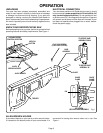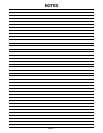
Page 8
BASE ASSEMBLY IN
REGULAR CUTTING POSITION
OPERATION
Fig. 6
TO INSTALL FLUSH CUTTING BLADES
See Figures 6 and 7.
Flush cutting blades should be used when making close or
flush cuts to walls.
1. Plug your reciprocating saw into power supply source.
2. Depress and release the switch trigger of your saw in
quick, short starts and stops until blade clamp is in its full
rear position.
See Figure 6.
3. UNPLUG YOUR SAW.
WARNING:
Failure to unplug your saw could result in accidental
starting causing serious injury.
4. Using the 5/32 in. allen wrench provided with your saw,
loosen the blade clamp screw and remove regular saw
blade.
5. Tighten blade clamp screw securely. Do not overtighten
screw or use an aid with allen wrench.
6. Loosen set screw and turn base assembly clockwise
90°.
See Figure 7.
7. Align in desired notch, then tighten set screw securely.
8. Remove allen wrench and store it in allen wrench
holder.
9. Insert flush cutting blade on top of blade clamp as shown
in figure 6.
10. Align hole in blade shank with pin on blade clamp.
11. Using the flat head screw provided, secure blade to
blade clamp.
See Figure 6.
12. Tighten flat head screw securely.
GENERAL CUTTING
See Figure 8.
Hold your saw firmly in front of and clearly away from you.
Make sure saw blade is clear of any foreign material and that
power cord and extension cord are out of the blade path. Be
sure material to be cut is held firmly. Small work pieces should
be securely clamped in a vise or with clamps to the work
bench or table. Mark the line of cut clearly. Depress the trigger
switch starting the cutting action, set the base assembly
against the work, then move the blade into the work. DO NOT
FORCE. Use only enough pressure to keep the saw cutting.
Let the blade and saw do the work.
PLUNGE CUTTING
See Figure 9.
Mark the line of cut clearly. Choose a convenient starting
point inside the area to be cut out and place the tip of the blade
over that point. Rest front edge of base assembly on work and
hold firmly in position. NOTE: Make sure blade does not
touch work until motor reaches full speed, since this could
cause loss of control resulting in serious injury. With saw
blade at full cutting speed, slowly tilt saw downward until tip
of blade starts cutting work. After blade penetrates work, tilt
saw until blade is perpendicular to the work.
Fig. 8
Fig. 7
PIN
BLADE
CLAMP
FLAT
HEAD SCREW
FLUSH
CUTTING BLADE
BASE ASSEMBLY IN FLUSH
CUTTING POSITION
SET
SCREW
FLUSH
CUTTING NOTCHES
BLADE CLAMP IN
FULL REAR POSITION














